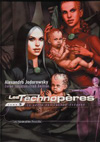

European Comics
European Comic Art
By Marc Jetté
November 25, 2003 - 14:44
Welcome to the Comic Book Bin's long awaited Euro Comics column. This feature, unique in English speaking comic book magazines is the ultimate reference for those of you who a) Can't go to Europe b) can't read French, Italian, German or Spanish and C) love comics, no matter where they're from. While mangas are well covered, I felt that there was a serious lack of information on European comics. No more!
 This week, we get two great articles on Euro comics. The first is by Marc Jetté. The second article is by Philip Schweier . It provides a solid historical recap for those of you who want to get their feet wet in European comics. Those more interested in the contemporary comics coming from Europe, will find Marc Jetté's article very helpful. As for the column, we planned several other features. If there's anything of interest that you would like us to cover, or if you want to drop us a line, email me. This week, we get two great articles on Euro comics. The first is by Marc Jetté. The second article is by Philip Schweier . It provides a solid historical recap for those of you who want to get their feet wet in European comics. Those more interested in the contemporary comics coming from Europe, will find Marc Jetté's article very helpful. As for the column, we planned several other features. If there's anything of interest that you would like us to cover, or if you want to drop us a line, email me.
Hervé
 European comic books, or to be more accurate, graphic novels, boast many facets. Each nationality and each country, has its own tradition. Some are better known than others. For example, the British have with Judge Dredd and Alan Moore. The Italians have Manara and Serpieri. The Spanish have Palacios. Some are less known but still energetic and with dedicated artists. Some, like the Germans, face difficulties, while others, like the French and Belgian thrive. The French and Belgian's « bande dessinée » has had seven straight years of continued growth. While American comic books have only recently Come out from a multi year sales slump, French and Belgian « bandes dessinées » show a remarkable growth, with various series selling from the tens of thousands to the hundreds of thousands, all at high prices. This is why many new publishers have appeared in the last two years and many new series are launched on a regular basis. Optimism is in the air. European comic books, or to be more accurate, graphic novels, boast many facets. Each nationality and each country, has its own tradition. Some are better known than others. For example, the British have with Judge Dredd and Alan Moore. The Italians have Manara and Serpieri. The Spanish have Palacios. Some are less known but still energetic and with dedicated artists. Some, like the Germans, face difficulties, while others, like the French and Belgian thrive. The French and Belgian's « bande dessinée » has had seven straight years of continued growth. While American comic books have only recently Come out from a multi year sales slump, French and Belgian « bandes dessinées » show a remarkable growth, with various series selling from the tens of thousands to the hundreds of thousands, all at high prices. This is why many new publishers have appeared in the last two years and many new series are launched on a regular basis. Optimism is in the air.
 European comic art, especially in France and Belgium, has commanded great respect and attention since the sixties. The public, media, upper classes and intellectuals dub it the 9th Art. This respect began with the publication of stories aimed specifically at adults, like Forest's Barbarella. The American underground movement was also instrumental, spurring numerous artists to leave behind old inhibitions. Specialized books and exhibitions also helped. Before that, the general perception was that comics were for children and teenagers. While this point of view is still strong in specific countries such as the United States and Canada, the Europeans have mostly succeeded in freeing the 9th Art from that restraining classification. A proof of that are European conventions and the people of all ages and walks of life are they attract people. European comic art, especially in France and Belgium, has commanded great respect and attention since the sixties. The public, media, upper classes and intellectuals dub it the 9th Art. This respect began with the publication of stories aimed specifically at adults, like Forest's Barbarella. The American underground movement was also instrumental, spurring numerous artists to leave behind old inhibitions. Specialized books and exhibitions also helped. Before that, the general perception was that comics were for children and teenagers. While this point of view is still strong in specific countries such as the United States and Canada, the Europeans have mostly succeeded in freeing the 9th Art from that restraining classification. A proof of that are European conventions and the people of all ages and walks of life are they attract people.
European comic art also distinguishes itself by the richness of its styles, humor or realistic, and by the vastness of its genres, whether science-fiction, fantasy, crime, horror, history, romance, or even eroticism. The manga sales are nothing short of enormous. The only monthly series found are usually anthologies showcasing various artists' works. The usual format for series is the annual graphic novel, presenting stories ranging from forty to sixty pages or more, which is sold at a high price that enables the creators involved to produce a work of consistent quality.
© Copyright 2002-2019 by Toon Doctor Inc. - All rights Reserved. All other texts, images, characters and trademarks are copyright their respective owners. Use of material in this document (including reproduction, modification, distribution, electronic transmission or republication) without prior written permission is strictly prohibited.
|
|